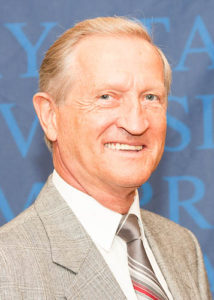Story by Lindsey Coleman, Staff writer
Michael Kalinski, department chair of Applied Health Sciences, helped expose a Russian Olympic doping scandal by sharing secret documents to several news outlets. He now incorporates his experience into his classes.

Kalinski said his expertise comes from the experience he has gained in his 19-year-position as the Chair of the Sport Biochemistry Department and the Research Vice President of the Keiv State Institute of Physical Culture in the former Soviet Union.
“Coming to Murray State was an opportunity to utilize my previous distinguished administrative experience as a department chair and as research vice president,” Kalinski said.
He said in his classes his students are studying doping in the 2012 Olympics and the investigation published by the World Anti-Doping Agency that led to the ban of certain Russian athletes from the 2016 Olympics.
Doping is the use of banned performance-enhancing drugs in competitive sports.
“It’s current. It’s 2016. It’s one of the turning points in the Olympic movement that the entire Russian track and field team was banned from the Rio Games… It is relevant,” Kalinski said.
Emma Boehm, sophomore from Waterloo, Illinois, said she is currently taking Kalinski’s Concepts and Careers in Exercise Science and Athletic Training course.
Boehm said she had the opportunity to read several documents about the doping issue and give a presentation about one of Kalinski’s articles.
“I think it is very interesting that the government was that into winning sports that they put their athlete’s lives in danger by giving them steroids,” Boehm said.
In interviews with news sources in the past several years, Kalinski said he shared secret documents which were obtained in 1972 as a result of his involvement with the USSR.
He said the documents he acquired prove how doping has been a longstanding issue in Russia.
“It reveals that the Soviet Union was one of the strongest Olympic teams ever,” Kalinski said. “It was winning gold medals… the US was behind. I am showing that that was all fake, because those athletes were doped, but nobody before me could prove that the Soviet Union had state-sponsored doping research.”
He said since the 2016 Russian Olympic team was caught for their doping practices, and his revealing documents prove Russian doping in the present is not new.
“The difference is I can do it for the past… this director of the doping lab is proving it for today,” Kalinski said.
He said he interviewed with several news outlets in the past few years, including ones from Germany, Japan, the Netherlands and Moscow, and he was also included in a German documentary.
Most recently, Kalinski said that he had the privilege of speaking with reporters from the Asahi Shimbun, a daily newspaper in Japan.
The article entitled Russia’s Doping Issue as Soviet Legacy was published on Sept. 21 and included a testimony from Kalinski.
On Sept. 29, Ichiro Matsuo of the Asahi Shimbun, thanked President Davies for the opportunity to come to Murray State and interview Kalinski.
In his letter of appreciation, Matsuo said that after publishing the article, it received good feedback from some of their 7 million paper subscribers and internet viewers.
In 2002, Kalinski published an article in which he explained the effects of doping in athletes and presented original data from secret Soviet research.
According to Kalinski’s article entitled Recommendations for Androgenic-Anabolic Steroid Use by Athletes in the Former Soviet Union: Revelations from a Secret Document, “The importance of this secret document, presented for the first time in the West, is that it provides the first solid evidence of State collusion by the USSR in steroid use by athletes.”
In his article published in 2003 called State-Sponsored Research on Creatine Supplements and Blood Doping in Elite Soviet Sport, Kalinski presents information about creatine supplements and blood doping in the USSR and how it shaped the standard of doping in Russia.
“Blood doping was pervasive in the USSR in the 1970s and 1980s and was used by many Soviet athletes in the 1976 and 1980 Olympic Games,” Kalinski said. “Open publication and discussion may help to prevent the abuses that can come from secret scientific research.”